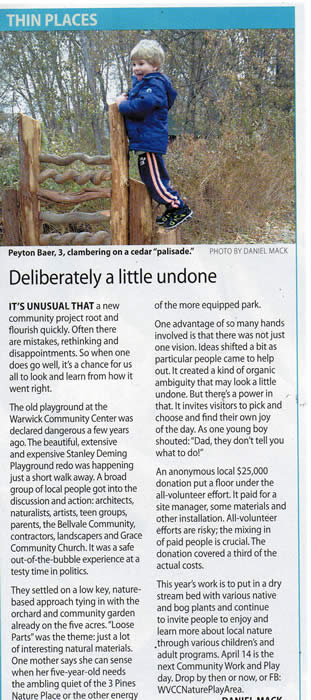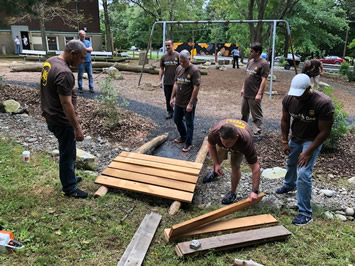
Nature Play as Placemaking Daniel Mack 3.15.19
Placemaking is about fresh effective ways of energizing and activating communities. It involves discovering ways to involve broad parts of the community into participation, a sense of ownership and pride. These are features essential to a vibrant community, but not easily quantified because the nature, the timbre of Community Life is always shifting. So this is a process that has to be tried and tried again. It’s a cyclical, regenerative process that, when it is working best, engages ever-new parts of the community into satisfying relationships with each other.
As it does each year, the Citizens Foundation recognizes home-grown Placemaking projects. In 2018, a project at a local Village Community Center was chosen for a $1000 award. As the report on that award, we present notes and a template for other communities interested in such a project.
Nature Play Area Primer for Placemaking
1. Developing the
Concept
Is there Interest? Is there a Need? Is there a local organization looking for a project to refresh its public image? Are there parents or nature enthusiasts or active retirees looking for a simple visible positive action project? Is a particular piece of land available? Is the municipality open to such a project?
A flyer, FB Post or local newspaper article on “Local Group explores Building a Nature Play Area” will be enough to get a good meeting going where ideas can be exchanged and developed. The Web is brimming with pictures, stories and directions for how a Nature Play Area develops. Even a brief web search can tune up the language and the benefits of such a project. And since “nature” is neither red nor blue, it’s a great “out-of-the-bubble’ community-wide project.
Have one or two Concept or Idea Meetings to get a practical sense: Are the right people available? Is the right project? And the right time for your Community. It may or may not be. It’s helpful to get some professional participation early in this process. Ask an architect, landscape architect, and a few contractors to join in for just a discussion. Again, because it’s “nature” for the Children and for the Community, you should get a lot of early cooperation.
We have found that success depends on making sure lots of people can feel “heard”; that it’s not seen as a project by just one small group. Remember, Placemaking is a Village Green activity: Everybody gets Access. Be sure to ask each meeting what people’s specific interests are. You may be surprised by the diverse range of related interests from Special Needs, to native plant gardens to play to chess boards to a “Carnivorous Plant Garden”
It’s important to explore just who might use or might want to use such a place. Who is your intended Target Audience? Do they need or want a place like this? Who Else might be attracted?
2. Visit Local Playgrounds and Other Nature Play areas
A key moment in our development was the visit to a large established Nature Play Area, Grasshopper Grove, in Cornwall, NY at the Hudson Highlands Nature Museum. The visit cemented the initial, developing interest in the project for those people who have never seen or visited such a place. They took pictures, watched and imagined a form of this in their neighborhood. It was a very special step in making the project real.
Similarly, visit the other nearest playgrounds to see what kinds of activities are already offered. What’s the climbing like, the seating, the level of activity and chance for quiet play. These visits will help more finely tune the complementary activities the new Nature Play Area can offer. This is essential to develop a list of what materials and activities your Nature Play area will need and offer.
Money
No, it cannot be an all-volunteer effort. Yes, you need money. Though a Nature Play Area can seem like just the annex to the Village Brush Pile, there are code concerns, fencing, several kinds of mulch and stone and sand that go into making it all look so casual, and yet safe. Early in the Concept process, we identified a local corporation and had local politicians help us make a pitch. Remember: “Children”, “Nature” and the apolitical quality of the place. We got $25K. Some Playgrounds start at $300K and range up to a million dollars. We were very alert to how little we could do this for. We wanted to show how much we could do for very little.
There are times when pro-bono work from an architect, landscape architect or contractor is just not enough; to need to buy their services; Sometimes you need to buy special playground mulch or pea gravel and the supplier will then give you a few loads of wood chips or sand. We hired a local fencing company to install new post and rail fencing along our street frontage. It may be easier to get native plants and shrubs donated. A local Pond and Waterfall builder donated about 200 SF of heavy pond liner scraps for our dry stream bed. It all depends on who knows who. It’s the process of Placemaking. “Hey, I know a guy!”
Plan It Out
 Someone with experience has to be involved
at this stage. We were lucky to have both a landscape architect who had run a
county park system and a regular architect. They came up with drawings
(included) and a plan of action that we are still working from two years later.
They both donated their time and expertise in these early stages and we paid
them a modest fee when our donation came through.
Someone with experience has to be involved
at this stage. We were lucky to have both a landscape architect who had run a
county park system and a regular architect. They came up with drawings
(included) and a plan of action that we are still working from two years later.
They both donated their time and expertise in these early stages and we paid
them a modest fee when our donation came through.
Installation
Actually building the place will likely happen in fits and starts. The architects and construction people should definitely help schedule what goes in when, but given the essentially informal quality of the whole thing, materials, especially donated materials, will show up whenever. Several regularly scheduled “Work Days” are helpful to handle getting all the pieces of this moved into place . This will require a coordinator, someone who really thinks about the logistics and the priorities. That person might likely get paid to do this. It’s a job. He/she can direct the willing parents, committee members, neighbors and other volunteers to move the wood chips, the mulch; to weed, rake and dig; to paint, plant and more. We were lucky to be an established Community Center. People knew of us; they had probably been there in the last hundred years when it was a school, pre-school, after-school program. They had likely gone to all sorts of meetings there. It was on the list of places area churches and corporations would send volunteer teams for a morning of “service” ( I remember very well the day a crew of five or six husky UPS guys showed up “to help out”. I never worked so hard finding more and more jobs for them. The Bridge I thought would take the better part of the morning was done in a half hour. “What’s Next?”)
We developed another vein of help through both the local high school and local Community College. Each had courses in Design, Landscape and both students and the teachers were very interested and diligent about using the Nature Play Area as a place to try out various design and landscape installation projects. Again, it was a good blending of the Commnity and the Schools.
The very impor tant side effect of this Installation
being a ersatz community effort is probably the most important part of its
Placemaking function. Lots, and lots of different, people have had
1st hand experience in making it. There’s built in rich foundation to
the project and a sense of giving back and belonging.
tant side effect of this Installation
being a ersatz community effort is probably the most important part of its
Placemaking function. Lots, and lots of different, people have had
1st hand experience in making it. There’s built in rich foundation to
the project and a sense of giving back and belonging.
Intended Use, and its Limits
We had intended our Nature Play Area for 2-7 year olds and perhaps help get our Pre-school going again. Nice Idea. But because we are in a populated Village, we got a wide range of people visiting. Walkers, dog walkers, Yes, parents with 2-7 year olds and teens on the prowl and teens at the events at the Community Center. It has made for a rather dilute use of the place, but it is all a part of the dynamics of placemaking.
Maintenance
ACH! This is the toughest part of the whole project. Just how much order should the Nature Place have? Not an easy question, nor answer. There are concerns for safety and cleanliness. But who rakes out the sand? How often? Who re-gathers the Loose Parts? What about Trash and Dog Poop? Nature Play does have a slight abandoned-lot quality, but there are limits. The parents who use it are pretty attentive and this year we are asking other groups who use the Community Center to help with general tidying.
More Information
3 Pines FB Page
Visit 3 Pines Nature Play Area Hamilton Ave, Warwick, NY 10990
Visit Grasshopper Grove, The Hudson Highlands Nature Museum, Cornwall, NY
Web Search: Nature Play, Loose Parts, Forest Schools, Olympia, WA Childrens Museum, Community Playthings, Grasshopper Grove, Hudson Highlands Nature Museum